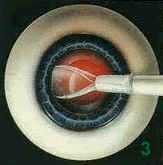
Prostheses:
Vision
 |
Neural Prostheses: Vision |
The most basic form of visual prosthesis is a pair of glasses: a machine which makes up for degradation or malformation of the eye. Ophthalmic technology evolution has transformed glasses into machines which, when used, feel more natural. Contact lenses enable the visually-impaired to look and feel like they have perfect vision without a cumbersome frame balancing on their ears and noses. This simulation of perfect vision is almost seamless, except when it is time to go to sleep, and the lenses must be taken out and cleaned, and them put back in the morning.
 The next step in this technological evolution was the creation and implementation of fully implantable lenses, which actually replace (or in some cases merely enhance) the old, dysfunctional lenses. The lenses are very small (as seen compared to a penny) and are put into the eye by a clever surgical procedure. Take, for example, a patient with cataracts. This means that
The next step in this technological evolution was the creation and implementation of fully implantable lenses, which actually replace (or in some cases merely enhance) the old, dysfunctional lenses. The lenses are very small (as seen compared to a penny) and are put into the eye by a clever surgical procedure. Take, for example, a patient with cataracts. This means that there has been a clouding of the lenses (Cataract is a Greek word meaning "white water falling." Early Greeks thought the blurred vision of a cataract was like looking through a waterfall). A small opening is made in the sac
there has been a clouding of the lenses (Cataract is a Greek word meaning "white water falling." Early Greeks thought the blurred vision of a cataract was like looking through a waterfall). A small opening is made in the sac  which holds the eye's diseased natural lens (Figure 1). A chemical is injected into the opening which dissolves the lens and the remains are vacuumed out. A special "folding lens" (Figure 2) is put into a needle like tube, and is injected into the now emptied sac (Figure 3). Within a short amount of time, vision is restored to the patient, and vision is rendered almost perfect (glasses may be necessary for reading).
which holds the eye's diseased natural lens (Figure 1). A chemical is injected into the opening which dissolves the lens and the remains are vacuumed out. A special "folding lens" (Figure 2) is put into a needle like tube, and is injected into the now emptied sac (Figure 3). Within a short amount of time, vision is restored to the patient, and vision is rendered almost perfect (glasses may be necessary for reading).
Dobelle points out that this work is the result of twenty years of work, and of the collaboration of hundreds of researchers. At this point, he and his colleagues have actually permanently implanted multiple volunteers with this system. Although Dobelle admits that the technology is not yet good enough, he stresses the value of perseverance as he endeavors to provide artificial vision for the blind.




